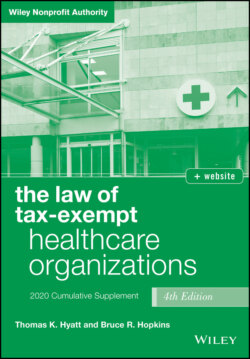Читать книгу The Law of Tax-Exempt Healthcare Organizations - Bruce R. Hopkins - Страница 6
На сайте Литреса книга снята с продажи.
Preface
ОглавлениеThis is the fifth cumulative supplement to accompany The Law of Tax‐Exempt Healthcare Organizations, fourth edition. It reviews developments in the tax law affecting the tax‐exempt healthcare sector through 2019. The last year of the “Tens” (or whatever it is we finally decided we were going to call this decade) was a year of fits and starts for the IRS, Congress, and the courts in reconsidering laws, both newly minted and longstanding.
The IRS continued to assess and pronounce on the ramifications of major tax reform legislation, principally the Tax Cuts and Jobs Act (TCJA), signed into law in 2017, including issuance (on 2018 New Year's Eve) of interim guidance on a provision that levies an excise tax on compensation in excess of $1 million annually for most nonprofit executives. The 92‐page missive provided answers to a bevy of hypothetical questions raised by the provision, while still leaving many to be answered in subsequent regulations.
Still another body of law provided by the TCJA, which is having substantial rippling effects throughout the exempt healthcare realm, is the so‐called bucketing rule, causing exempt entities to identify (or try to) separate unrelated businesses and calculate—separately—their gains and losses. Extensive IRS interim guidance provides insights, in this setting, as to allocation of expenses, investment activities as businesses, treatment of partnership interests, and—yes—application of NAICS codes.
On another TCJA front, in late 2018 the IRS issued interim guidance on a much‐pilloried provision in the law that imposed a “parking tax” on unrelated business income attributable to employee parking expenses in connection with the qualified transportation fringe benefit rules. It led to great consternation throughout the tax‐exempt sector and sentenced accountants to walk through parking lots with tape measures, calculating the dimensions of parking spaces, and security guards to spy on members of the public using “employee only” parking spaces. In a rare moment of bipartisan agreement, Congress acknowledged that the revenue‐raising provision was a compliance disaster and repealed the provision in December of 2019. In so doing, it created another administrative nightmare by making the repeal retroactive to the inception of the provision, as if the tax was never in the original law, thereby obsoleting the new guidance and leaving tax‐exempts to file for refunds of taxes paid and creating the need for new guidance as to how that will all work out. We have left our analysis of the parking tax provisions in this cumulative supplement for future reference, with the hope that it also serves as a cautionary tale for drafters of future tax reform initiatives.
Meanwhile, the IRS has had to apply decades‐old provisions of the Code to the nonprofit activities of a new era, tackling such questions as whether providing blockchain technology for use in the conduct of financial businesses is an educational activity and whether cannabis‐related services organizations may qualify as charitable tax‐exempt organizations. The latter of these occurs in the midst of a legislative and societal sea change, as states are taking an increasingly liberal approach to the regulation of medicinal and recreational use of cannabis (33 of them permitting it in some form as of late 2019), while the federal government has remained steadfast in its position of classifying cannabis as a controlled substance and refusing to recognize the health benefits of its use. The IRS, in two rulings in 2019, adhered to the federal position (as it must) and determined that nonprofit organizations involved in various aspects of providing cannabis that did so legally under state law do not qualify as charitable organizations because they have illegal purposes that violate federal law.
In other ruling areas, the IRS continues to vigorously apply the commerciality and private benefit doctrines, and does so liberally in the nonprofit healthcare context. The law as to nonqualification as a tax‐exempt business league likewise continues to be informed by the efforts of healthcare applicants. IRS rulings concerning excess benefit transactions, lobbying, and joint operating agreements round out this list.
As for the courts, in an important federal district court case, the court decided to upend the longstanding regulatory criteria for qualification as a tax‐exempt educational institution, holding that, as a matter of statutory construction, these criteria exceeded the bounds of authority provided by the statute and are thus unlawful. Unfortunately, this decision interprets the law of public charities in a contradictory fashion that runs afoul of another contextual canon: the absurdity doctrine.
The year 2020 promises to be fraught with political contentiousness and the likely near standstill of government as the elections play out. Still, even under such conditions and with staff and budgetary constraints, the IRS assured us in the Tax Exempt/Government Entities fiscal year 2020 program letter that it “will continue to pursue the most egregious noncompliance by evolving our technology tools and data analytics.” Never doubt that Big Brother is watching.
We appreciate the assistance we have received from John Wiley & Sons in the preparation of this cumulative supplement. Our thanks are extended, in particular, to our development editor, Brian T. Neill, Elisha Benjamin, project editor, and Koushika Ramesh, production editor, for their assistance and support in connection with this cumulative supplement.
Thomas K. Hyatt
Bruce R. Hopkins
February, 2020
